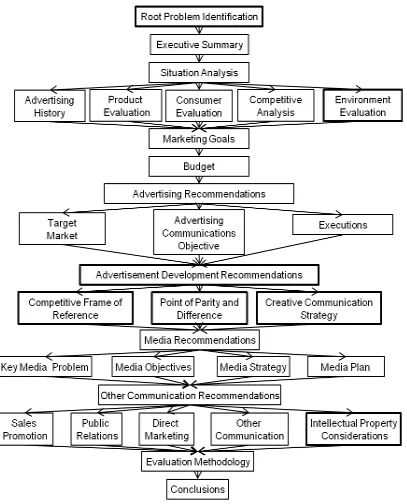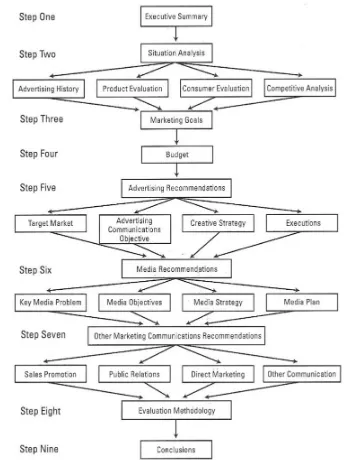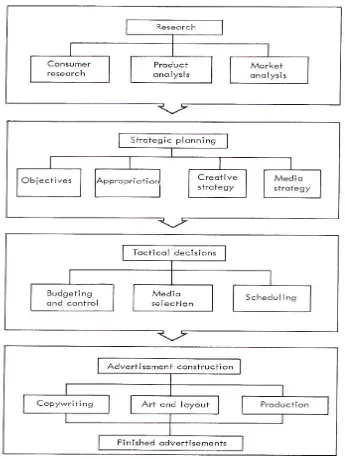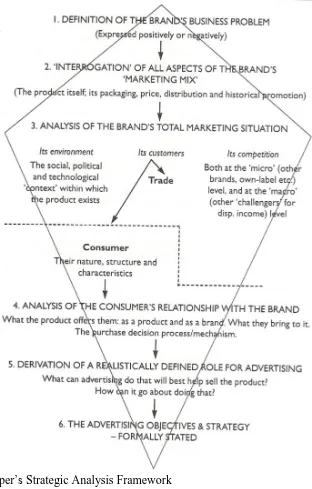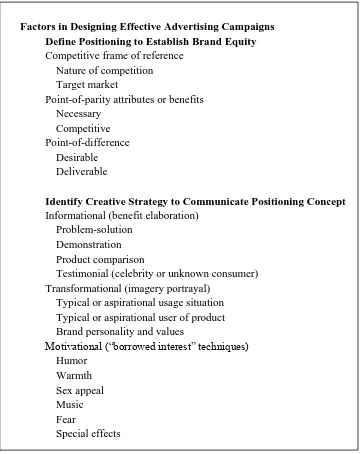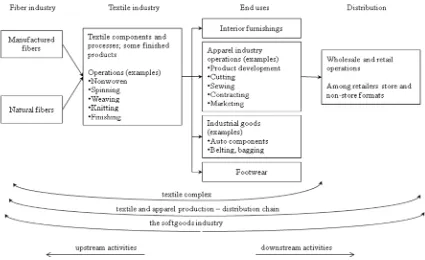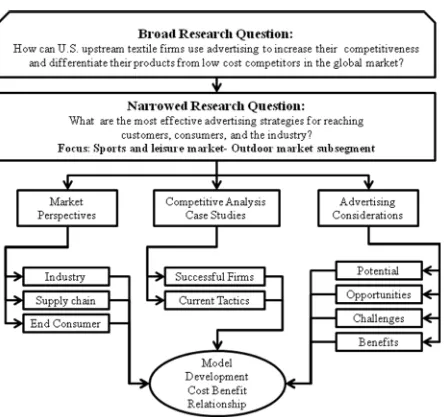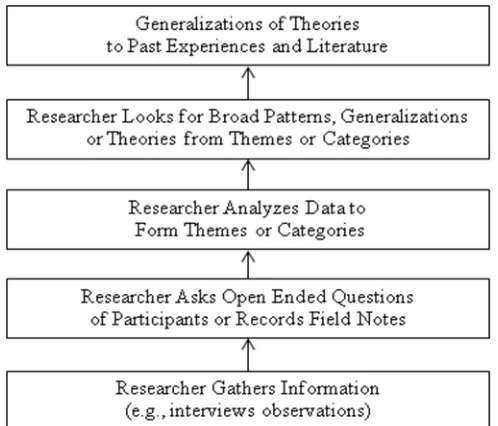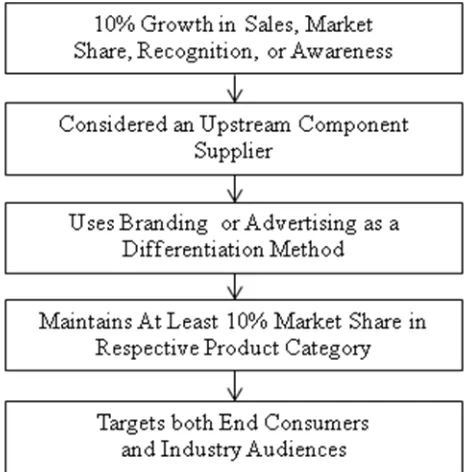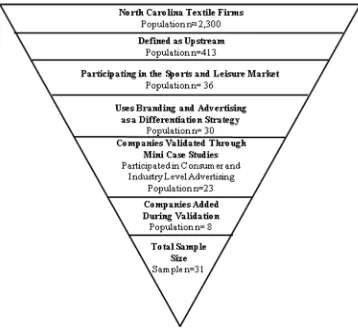ABSTRACT
RAULSTON, CHARLES IAN. Analysis of the Market Potential and Effectiveness of Upstream Textile Advertising. (Under the direction of Dr. Nancy Cassill and Dr. William Oxenham).
The United States’ (U.S.) textile industry has traditionally competed on cost measures in
order to gain market share in the global market. However, because of increased globalization
and influences from foreign competition, using a low cost strategy has become more difficult
and firms are now looking for less price sensitive methods of differentiation. Advertising has
been identified as an effective method of differentiating products and building value for the
firm. Upstream firms, such as those involved in fibers, yarns, and fabrics, which do not
directly sell to the final consumer, often have trouble communicating product benefits to the
end users, as well as their immediate customers in their supply chain.
The purpose of this study was to determine how U.S. textile firms can use advertising to
differentiate their products and how to communicate product benefits to their customers and
the end consumer effectively through media choices and advertisement content. This study
was completed using quantitative surveys among end use consumers and interviews with
firms with successful upstream advertising strategies. The results of this research were used
to develop a procedural model that U.S. textile firms can use to develop effective advertising
strategies to differentiate their products in the market and increase competitiveness. The
results provided companies with a framework they can use to develop their advertising
strategy by guiding them though the advertisement development methodology in order to
The results of the study identified online advertising as a potentially effective way to
communicate messages to consumers and entities in the textile supply chain. The benefits,
challenges, opportunities and potential of upstream textile advertising were identified. In
addition, the study identified effective strategies for communicating with end consumers,
supply chain representatives, and the industry. Consumer and supply chain level
perspectives were also collected related to the effectiveness of current advertising campaigns.
The framework developed during the study highlights methodology and considerations
specific to the upstream segment of textile industry and provides a sequential model for
Analysis of the Market Potential and Effectiveness of Upstream Textile Advertising
by
Charles Ian Raulston
A thesis submitted to the Graduate Faculty of North Carolina State University
in partial fulfillment of the requirements for the Degree of
Master of Science
Textiles
Raleigh, North Carolina
2009
APPROVED BY:
___________________________ ___________________________
Dr. Nancy L. Cassill Dr. William Oxenham
Co-Chair of Advisory Committee Co-Chair of Advisory Committee
___________________________ ___________________________
Dr. Erin Parrish Dr. W. Gilbert O’Neal
BIOGRAPHY
Ian Raulston was born in High Point, North Carolina to Keith and Resa Raulston in
1985. After graduating from Thomasville High School in 2003, he enrolled at the North
Carolina State University’s College of Textiles. Having been awarded two full scholarships,
the Park and Centennial Scholarship, his undergraduate career was focused on academics and
community service. During his summers, Raulston has had the privilege of working for the
Institute of Textile Technology in 2005, and Glen Raven in 2006 and 2007. Raulston
graduated as a valedictorian with a Bachelor of Science in Textile Management with a
concentration in branding and marketing, in 2008. After graduation, Raulston became an
Institute of Textile Technology Fellow, choosing to pursue his Masters of Science in Textile
Technology Management. He interned with Highland Industries during the summer of 2008.
Upon graduation, Raulston will be seeking employment in the field of marketing or
advertising. In his spare time, Raulston is an active barefoot runner, whitewater kayaker, and
ACKNOWLEDGEMENTS
I would first like to express my appreciation to my co-chairs Dr. Nancy Cassill and
Dr. William Oxenham. Their guidance, encouragement, dedication, and patience provided
me with the tools and the strength to complete this study. I would also like to thank Dr. Erin
Parrish for her commitment to helping me to make sense of it all and to succeed in my
endeavor. I want to thank Patrice Hill and Merisa Velebir for their support and laughs over
the last two years. I would also like to express my appreciation to the Staff of the Institute of
Textile Technology and the membership for putting together a challenging and fulfilling
academic program. I would also like to thank my fellow ITT classmates for their support,
their encouragement, and the love that we have shared during our ITT experience. They have
been like a second family to me, and I hope we never lose touch with one another.
Last, but most importantly, I would like to express my deepest gratitude to my Mom,
Dad, family, and friends for their support and unconditional love. I really appreciate you all
TABLE OF CONTENTS
LIST OF FIGURES ... xiii
LIST OF TABLES ... xiv
INTRODUCTION...1
CHAPTER I ...1
Purpose of Research ...2
Research Objectives ...3
Significance of Study ...6
Limitations ...6
Definitions of Relevant Terms ...7
CHAPTER II ...11
LITERATURE REVIEW ...11
Conceptual Framework ...11
Frameworks Used to Adapt Study’s Conceptual Framework ...11
Performance Textiles ...21
Sports and Leisure Segment and the Outdoor Market ...21
Defining Upstream and Upstream Advertising ...23
Advertising Effectiveness Theory ...25
Effectiveness Evaluation Methods ...27
Advertising Success ...28
Advertising Effects ...29
Positive Benefits ...29
Negative Impacts ...29
Advertising Challenges ...30
Differences Between B2B and B2C Advertising ...30
Current Strategies for Differentiation...31
General Methodology for Textile Advertisement Development ...31
Direct Marketing ...33
Affiliate Advertising ...34
Summary ...35
CHAPTER III ...36
METHODOLOGY ...36
Purpose of Research ...36
Research Objectives ...38
Research Design...40
Strategies and Theories ...40
Four Phase Approach: Explanation of Significance ...42
Phase I: Exploratory ...43
Data Collection: Phase I (Step 1) ...43
Data Collection: Phase I (Step 2) ...43
Data Collection: Phase I (Step 3) ...45
Data Collection: Phase I (Step 4) ...47
Data Collection: Phase I (Step 6-8)...49
Phase 1 Sample Selection: ...50
Phase II: Inductive Logic ...53
Data Collection: Phase II ...53
Sample Selection: Phase II ...53
Instrument Development: Phase II ...60
Data Analysis ...62
Phase III- Deductive Logic ...62
Data Collection: Phase III ...62
Sample Selection: Phase III ...64
Instrument Development: Phase III ...64
Data Analysis ...70
Phase IV- Model Development ...70
CHAPTER IV...71
RESULTS AND DISCUSSION ...71
Phase I: Exploratory ...71
Phase I: Initial Product Scan Results ...71
Objectives ...71
Key Findings ...71
Introduction...72
Product Scan Discussion ...76
Phase I: Print Advertising Media Scan Results ...78
Objectives ...78
Key Findings ...79
Phase 1: Competitive Analysis ...79
Objectives ...79
Key Finding ...79
Introduction...80
Discussion ...80
Phase I: Case Studies ...83
Objectives ...83
Key Findings: ...84
Case Study: Intel’s Intel Inside Campaign ...84
Introduction ...84
Opportunity ...84
Challenges and Media Tactics ...85
Benefits ...87
Case Study: Cotton Incorporated’s Fabric of Our Lives Campaign ...87
Introduction ...87
Tactics and Media Strategy ...88
Benefits and Successes ...89
Discussion: Case Studies ...89
Phase II- Industry Interview Results: Inductive Logic ...90
Objectives ...90
Key Findings ...91
Advertising in the Sports and Leisure Market ...93
Discussion: Advertising in the Sports and Leisure Market ...93
Advertising Benefits ...96
Discussion: Advertising Benefits ...96
Advertising Challenges ...99
Discussion: Advertising Challenges ...101
Advertising Opportunities ...101
Discussion: Advertising Opportunities ...101
Advertising Potential ...104
Discussion: Advertising Potential...104
Advertisement Development Methodology ...107
Discussion: Advertisement Development Methodology ...109
Advertising Effectiveness from a Supply Chain Perspective ...110
Discussion: Advertising Effectiveness from a Supply Chain Perspective...113
Phase III- Consumer Survey Results: Deductive Logic ...113
Objectives ...113
Key Findings ...114
Introduction ...115
Discussion: Advertisement A Survey Results- Individual Questions...118
Discussion: Advertisement B Survey Results- Individual Questions ...121
Discussion: Advertisement C Survey Results- Individual Questions ...124
Discussion: General Advertising Preferences Survey Results ...126
Phase IV- Conceptual Framework Revisions ...131
Objectives ...131
Discussion: Model Development ...133
CHAPTER V ...137
SUMMARY, CONCLUSIONS, AND RECOMMENDATIONS ...137
Summary of Research ...137
Summary of Results ...138
Benefits, Potential, and Challenges of Upstream Advertising ...138
Strategies used in the Performance Market ...140
Effective Strategies for Communicating with Industry, Customers, and Consumers ..142
Cost Benefit Relationship ...144
Conclusions ...145
Limitations ...148
Recommendations ...149
REFERENCES ...151
APPENDIX ...154
APPENDIX A: INITIAL COMPANY SAMPLE ...155
APPENDIX B: INTERVIEW INSTRUMENT ...168
APPENDIX C: CONSUMER SURVEY ...171
APPENDIX D: IRB SUBMISSION FORM ...179
APPENDIX E: IRB CONSENT FORMS ...192
APPENDIX F: INITIAL CONTACT LETTERS ...199
APPENDIX G: IRB EXEMPTION LETTER ...203
APPENDIX H: PRODUCT SCAN RESULTS...205
APPENDIX I: COMPANY INTERVIEW RESULTS: ADVERTISING IN THE SPORTS AND LEISURE MARKET ...209
Appendix I3: Company C Interview Results ...211
Appendix I4: Company D Interview Results ...212
Appendix I5: Company E Interview Results ...213
Appendix I6: Company F Interview Results ...214
Appendix I8: Company H Interview Results ...216
Appendix I9: Company I Interview Results ...216
Appendix I10: Company J Interview Results ...217
Appendix I11: Company K Interview Results ... Error! Bookmark not defined. APPENDIX J: COMPANY INTERVIEW RESULTS: ADVERTISING BENEFITS...218
Appendix J1: Company A Interview Results ...219
Appendix J2: Company B Interview Results ...220
Appendix J3: Company C Interview Results ...221
Appendix J4: Company D Interview Results ...221
Appendix J5: Company E Interview Results ...221
Appendix J6: Company F Interview Results ...222
Appendix J7: Company G Interview Results ...222
Appendix J8: Company H Interview Results ...223
Appendix J9: Company I Interview Results ...223
Appendix J10: Company J Interview Results ...224
Appendix J11: Company K Interview Results ...224
APPENDIX K: COMPANY INTERVIEW RESULTS: ADVERTISING CHALLENGES ...225
Appendix K1: Company A Interview Results ...226
Appendix K2: Company B Interview Results ...226
Appendix K3: Company C Interview Results ...226
Appendix K4: Company D Interview Results ...227
Appendix K5: Company E Interview Results ...227
Appendix K7: Company G Interview Results ...228
Appendix K8: Company H Interview Results ...228
Appendix K9: Company I Interview Results ...229
Appendix K10: Company J Interview Results ...229
Appendix K11: Company K Interview Results ...230
APPENDIX L: COMPANY INTERVIEW RESULTS: ADVERTISING OPPORTUNITIES ...231
Appendix L1: Company A Interview Results ...232
Appendix L2: Company B Interview Results ...233
Appendix L3: Company C Interview Results ...233
Appendix L4: Company D Interview Results ...234
Appendix L5: Company E Interview Results ...234
Appendix L6: Company F Interview Results ...235
Appendix L7: Company G Interview Results ...236
Appendix L8: Company H Interview Results ...236
Appendix L9: Company I Interview Results ...237
Appendix L10: Company J Interview Results ...237
Appendix L11: Company K Interview Results ...237
APPENDIX M: COMPANY INTERVIEW RESULTS: ADVERTISING POTENTIAL ...238
Appendix M1: Company A Interview Results ...239
Appendix M2: Company B Interview Results ...239
Appendix M3: Company C Interview Results ...240
Appendix M4: Company D Interview Results ...240
Appendix M5: Company E Interview Results ...241
Appendix M6: Company F Interview Results ...241
Appendix M7: Company G Interview Results ...242
Appendix M10: Company J Interview Results ...243
Appendix M11: Company K Interview Results ...244
APPENDIX N: COMPANY INTERVIEW RESULTS: METHODOLOGY ...245
Appendix N1: Company A Interview Results...246
Appendix N2: Company B Interview Results ...247
Appendix N3: Company C Interview Results...247
Appendix N5: Company E Interview Results ...249
Appendix N6: Company F Interview Results ...250
Appendix N7: Company G Interview Results ...251
Appendix N8: Company H Interview Results ...252
Appendix N9: Company I Interview Results ...253
Appendix N10: Company J Interview Results ...253
Appendix N11: Company K Interview Results ...254
APPENDIX O: COMPANY INTERVIEW RESULTS: ADVERTISING EFFECTIVENESS ...255
Appendix O1: Company A Interview Results ...256
Appendix O2: Company B Interview Results ...256
Appendix O3: Company C Interview Results ...257
Appendix O4: Company D Interview Results ...257
Appendix O5: Company E Interview Results ...258
Appendix O6: Company F Interview Results ...258
Appendix O7: Company G Interview Results ...259
Appendix O8: Company H Interview Results ...260
Appendix O9: Company I Interview Results ...260
Appendix O10: Company J Interview Results ...261
Appendix O11: Company K Interview Results ...261
APPENDIX P: CONSUMER SURVEY RESULTS: INDIVIDUAL ADVERTISEMENT...262
Appendix P2: Consumer Survey Results- Response Totals for Question 2 ...263
Appendix P3: Consumer Survey Results- Response Totals for Question 3 ...263
Appendix P4: Consumer Survey Results- Response Totals for Question 4 ...264
Appendix P5: Consumer Survey Results- Response Totals for Question 5 ...264
Appendix P6: Consumer Survey Results- Response Totals for Question 6 ...264
Appendix P7: Consumer Survey Results- Response Totals for Question 7 ...265
Appendix P8: Consumer Survey Results- Response Totals for Question 8 ...265
Appendix P9: Consumer Survey Results- Response Totals for Question 9 ...265
Appendix P10: Consumer Survey Results- Response Totals for Question 10 ...266
Appendix P11: Consumer Survey Results- Response Totals for Question 11 ...266
Appendix P12: Consumer Survey Results- Response Totals for Question 12 ...266
Appendix P13: Consumer Survey Results- Response Totals for Question 13 ...267
Appendix P14: Consumer Survey Results- Response Totals for Question 14 ...267
Appendix P15: Consumer Survey Results- Response Totals for Question 15 ...267
Appendix P16: Consumer Survey Results- Response Totals for Question 16 ...268
Appendix P17: Consumer Survey Results- Response Totals for Question 17 ...268
LIST OF FIGURES
Figure 1: Adapted Advertising Methodology Model ...12
Figure 2: Schultz and Barn’s Advertising Campaign Planning Process ...15
Figure 3: Sandage, Fryburger, & Rotzoll Advertising Components Model ...16
Figure 4: Cooper’s Strategic Analysis Framework ...18
Figure 5: Keller’s Factors for Effective Advertisements ...20
Figure 6: Dickerson’s Textile and Appareal Production-Distribution Chain ...24
Figure 8:Inductive Research Approach ...41
Figure 9: Deductive Research Approach ...41
Figure 10: Visual Depiction of Steps to Select Successful Companies ...49
Figure 11: Case Study Company Selection Criteria ...51
Figure 12: Industry Interview Sample Selection Process ...54
Figure 13: Advertisement A ...68
Figure 14: Advertisement B ...69
Figure 15: Advertisement C ...69
Figure 16: Advertisement Content Credibility Source Preferences ...128
Figure 18: Percentage of Consumers Preferring Branded Textiles Over Generics ...129
Figure 19: Consumer Information Source Preferences ...130
LIST OF TABLES
Table 1: Framework Evaluation...13
Table 2: Phase I Instrument- Secondary Data Collection ...44
Table 3: Companies Participating in the Sports and Leisure ...56
Table 4: Companies Participating in the Sports and Leisure Using Branded Products .57 Table 5: Validated Companies Participating in the Sports and Leisure Using Branded Products and Advertising in the Consumer and/or Industrial Segments ...58
Table 6: Companies Selected based Upon Leadership and Visibility in Advertising or Expertise in Advertising with Textile Companies...60
Table 7: Interview Instrument- Question Source and Research Objective Correlation ...61
Table 8: Consumer Survey Instrument- Question to Research Objective Correlation ...65
Table 9: Product Scan Summary Findings by Product Type ...73
Table 10: Competitive Analysis Results ...81
Table 11: Advertising in the Sports and Leisure Market- Summary of Results ...94
Table 12: Advertising Benefits- Summary Results ...97
Table 13:Advertising Challenges- Summary Results ...100
Table 14: Advertising Opportunities- Summary Results ...102
Table 15: Advertising Potential- Summary Results ...105
Table 16: Advertisement Development Methodology- Summary Results ...108
Table 17: Advertising Effectives from a Supply Chain Perspective- Summary Results ...111
Table 18: Consumer Survey Results- Demographic Information ...116
Table 19: Consumer Survey Results: Advertisement A - Individual Questions ...117
Table 20: Consumer Survey Results: Advertisement B- Individual Questions ...120
Table 21: Consumer Survey Results: Advertisement C- Individual Questions ...123
CHAPTER I INTRODUCTION
The United States’ (U.S.) textile industry has traditionally competed on cost measures in
order to gain market share in the global market. However, because of increased globalization
and influences from foreign competition, using a low cost strategy has become more difficult
(Dickerson, 1999). Firms are now looking for new ways to differentiate their products that
are not price sensitive. For apparel, branding and private labels are an obvious choice to
distinguish their products. However, upstream firms, such as those involved in fibers, yarns,
and fabrics, which do not directly sell to the final consumer, often have trouble
communicating product benefits to the end users, as well as their immediate customers in
their supply chain.
In order to effectively differentiate their products and to reverse this poor communication
trend, firms must create both customer and consumer level demand for upstream products.
By creating a value–added proposition, apparel and textile retailers may be able to justify a
higher price. This can be accomplished through promotional activities such as pull/pull
marketing, public relations (PR), sales promotion, and advertising. The best way to
communicate product benefits to customers and consumers is through effective advertising
(Keller, 2003). However, each company and target customer is unique and not all strategies
are universally successful. Therefore, in order to create a viable business strategy that U.S.
textile firms can use to determine the market potential for an advertising campaign, current
Advertising effectiveness is a measurement of the tangible contributions advertising
makes to the brand or the company (Wright-Isak, Faber, & Horner, 1997). There is no
universally agreed upon procedure for assessing the standard of performance for advertising.
Most businesses use sales volume as a measurement of success, but this procedure fails to
capture the nonmonetary benefits of advertising such as awareness and perceptions. It has
been suggested that both qualitative and quantitative measures should be employed to access
advertising effectiveness. However, with the diverse benefits and roles of advertising, there
are no standards for advertising success (Wright-Isak, Faber, & Horner, 1997). Typically, it
is up to the individual company to measure and evaluate their own set standards. Much like
the procedure for measuring effective advertising, there is no set standard for what
constitutes a successful advertising campaign. From the literature, it has been stated that it is
up to the individual company to determine whether an advertising campaign was successful
or not (Wright-Isak, Faber, & Horner, 1997).
Purpose of Research
The purpose of this research was to examine upstream textile firms that effectively
used advertising to differentiate their products in the market. The broad research question
was how could U.S. upstream textile firms use advertising to increase their competitiveness
and differentiate their products from low cost competitors in the global market? From the
broad research question, the narrowed focus was to determine the most effective advertising
strategies for reaching customers, consumers, and the industry. Specific research questions,
1. What are the benefits, challenges, opportunities and potential of upstream
advertising?
2. What are some different strategies used in the performance market? Focusing on
the sports and leisure market and outdoor apparel and equipment subsegment?
3. What are the most effective strategies for U.S. textile firms to use in order to
communicate with the customer and the end-use consumer? What perspectives do
the following groups have about advertising:
a. End consumers;
b. Customers;
c. Industry?
4. How can this knowledge be presented to help upstream textile firms create value
and differentiate their products?
5. What is the cost/benefit relationship between money spent on advertising and
realized gains for the firm?
Research Objectives
Phase I: Exploratory
RO1: Define advertising success and identify companies with successful advertising
strategies.
RO2: Complete a competitive analysis, using secondary data, on the advertising strategies of
upstream textile manufacturers in addition to the strategies of upstream firms from other
RO2A: Develop an understanding of the current advertising campaigns.
RO2B: Assess the strategies used by the selected companies.
Phase II:Inductive Logic Phase II and III will be conducted concurrently.
RO3: Examine differences in the marketing strategies used by the performance textile
market, focusing specifically on the outdoor apparel and equipment subsegment of the sports
and leisure market segment.
RO3A: Assess benefits
RO3B: Assess challenges
RO3C: Assess opportunities
RO3D: Assess potential
RO3E: Advertising methodology
RO4: Examine the effectiveness from a supply chain perspective to determine:
RO4A: Which media types the population views most frequently
RO4B: What advertising media has the best response rate
RO4C: What part of the advertisement causes the population to
seek additional information
RO4D: What features of the advertisement are most effective
RO4E: What factors the population considers before purchasing
Phase III: Deductive Logic
RO5: Examine the effectiveness of upstream advertising from an end consumer perspective
to determine:
RO5A: If the population is aware of the advertised ingredient product
RO5B: If the population knows the functionality of the ingredient product
RO5C: What features of the advertisement the population feels are most effective
RO5D: If the population looks for the ingredient when purchasing products
RO5E. If the population is willing to pay more
RO5E: Where the population seeks product information
RO6: Develop an understanding of the potential of upstream textile advertising focusing on
different advertising opportunities including:
RO6A: Print
RO6B: Television
RO6C: Internet
Phase IV: Model Development
RO7: Develop a framework that U.S. textile companies can use to develop a successful
upstream advertising campaign.
RO7A: Provide ITT member companies with the knowledge and guidelines
Significance of Study
The significance of this study is fourfold. First, the results of this research will
provide knowledge of the benefits, challenges, opportunities, and potential of upstream
advertising. This knowledge will aid companies in determining the cost/benefit relationship
of advertising for their company and could aid in managerial decision-making.
Second, it will determine the most effective strategies for U.S. textile firms to use in
order to communicate with the customer and the end-use consumer for the performance
market. This will allow firms to determine what advertising communication media type best
fits their target market.
Third, it will provide a framework for U.S. textile firms to use when implementing an
upstream advertising strategy.
Finally, it will provide a means for U.S. textile firms to create perceived value and
differentiation. By understanding the nature of the upstream advertising, U.S. producers will
be ideally positioned to gain a competitive advantage through differentiation.
Limitations
1. This study was specifically limited to the upstream textile firms participating in the
sports and leisure segment of the performance textile market. Companies interviewed
are representative of the upstream segment of the industry, but not the entire industry.
Therefore, the results presented in this report cannot be generalized for all segments
2. Participants in the consumer survey are limited, but are representative of the
population. Because a non-probability convenience sample was used during the study,
the results presented in this report cannot be generalized for the entire population.
Biases in awareness may have occurred due to fact that upstream companies have
sponsored events and programs on the College of Textiles campus.
3. Respondent bias may be present in surveys and interviews, due to their willingness or
unwillingness to disclose certain data.
4. Advertising is only one component of promotional activities. While companies can
achieve success through other promotional avenues, this study only focuses on the
advertising portion of the mix.
5. Due to the markets and consumer preferences of Raleigh/Cary, North Carolina area,
the availability and selection of products and publications identified in this study are
limited. Therefore, the results of this study are geographically limited and cannot be
applied to all geographic areas.
Definitions of Relevant Terms
1. Advertising Failure: Campaigns or individual advertisements that do not meet
pre-established company objectives that may take the form of increased sales, new
customers, increased market share, or increased brand/product/service/company
awareness (adapted from Vass, 2005).
2. Advertising Success: Campaigns or individual advertisements that meet
customers, increased market share, or increased brand/product/service/company
awareness (adapted from Vass, 2005).
3. Brand: A representation of promises, images, or experiences associated with a
product in the mind of the consumer (Kegan, 2005).
4. Brand image: Complex array of images associated with a product and the maker of
that product (Kegan, 2005).
5. Channel of Distribution: The collection of agencies that perform the actives required
to link producers with users (Kegan, 2005).
6. Collateral: Printed company or product brochures or pamphlets, distributed to
potential customers.
7. Competitive Advantage: The meeting of the firm’s core competencies and the factors
required to yield significant customer value (Kegan, 2005).
8. Differentiation: The ability of a firm to serve a large market and be perceived as
having unique products, often allowing for premium pricing (Kegan, 2005).
9. Downstream: Relates to the relative position of a company in relation to other
companies. These companies are further along in the supply chain, close to the
consumer. Companies may include finished goods companies, marketer, wholesalers,
and retailers (adapted from Dickerson, 1999).
10.Host Brand: Product or brand that allows another company’s brand to be promoted on
or with their product, in an effort to build brand equity and creditability for the
11.Ingredient textile: Includes any fiber, yarn, fabric, or finish used to create a product
(Desai, 2002).
12.Outdoor Market Segment: Segment of the sports and leisure includes: Apparel (sport
and weather resistant jackets, vests, and pants); Accessories (hats, socks and gloves);
Footwear (hiking shoes and hiking/hunting boots); and Equipment (tents, sleeping
bags, and backpacks/daypacks) (adapted from NC Textile Connect, 2008).
13.Performance Textiles: Classification of textile products that combine technical
performance with esthetic dimensions to fulfill specific end uses and niches. These
products include those used in the agriculture, construction, apparel, geotextile, home
furnishings, military, industrial, medical, transportation, environmental, packaging,
and sports and leisure sub sectors. Non-performance products may include
commodity goods (Nelson, 2008).
14.Positioning: Creating certain associations in the mind of users compared to
competitors (Kegan, 2005).
15.Public Relations (PR): Component of the marketing mix that monitor and evaluate
public opinion about a company or its products (Keegan & Green, 2005).
16.Sports and Leisure Segment: Product category includes any recreational and
consumer goods including tents, backpacks, fabric covered sport balls, awnings,
umbrellas, etc. (NC Textile Connect, 2008).
17.Supply Chain: Group of agencies that facilitate the conversion of raw materials into
18.Targeting: Act of evaluating market segments and concentrating marketing efforts on
a specific country, area, or consumer group (Kegan, 2005).
19.Upstream: Companies that produce or support the production of textile fibers, yarns,
and fabrics (both finished and greige) (adapted from Dickerson, 1999).
20.Upstream Advertising: The act of communicating a sponsored or paid message
through a non-personal channel including trade shows, showrooms, hang tags, print
advertisements, Internet advertisements, and sponsored events. Messages can be
product, company, or service oriented (adapted from Kegan, 2005).
21.Value: A consumer’s perception of benefits from a firm’s product or service relative
CHAPTER II LITERATURE REVIEW
Conceptual Framework
The conceptual framework used for this research study was a modified version of the
Shultz and Barn’s Advertising Campaign Planning Process Model (1999). This adapted
model, Figure 1, illustrates the advertising planning process from the inception, through the
implementation and feedback stages, including secondary considerations such as public
relations and sales activities. This adapted model was developed using several inputs from
other advertising strategy models, including the Sandage, Fryburger, & Rotzoll Advertising
Component Model (Sandage, Fryburger, & Rotzoll, 1983), the Cooper Strategic Analysis
Framework (Cooper, 1997), and Keller’s Factors in Designing Effective Advertising
Campaigns (Keller, 2003). The segments added from these models were denoted by bolded
boxes in Figure 1. Justification for these additions can be found in the following section.
Frameworks Used to Adapt Study’s Conceptual Framework
The synthesis of this model was developed by combining elements from four
different strategy perspectives, each with unique elements that were incorporated into the
final model. The Schultz and Barn’s Advertising Campaign Planning Process (Schultz &
Barns, 1999) acted as the basis for the adapted model. Table 1 outlines the framework
evaluation process and identifies the strengths and weakness of each model, as well as the
Figure 1: Adapted Advertising Methodology Model
Source: Adapted by I. Raulston (2009) Schultz, D. E., & Barns, B. E. (1999). Strategic Brand Communication Campaigns. Chicago, IL: NTC Business Books. 68.
Framework Evaluation
Framework Evaluation
Model Components Strengths Weaknesses
Schultz & Barns
Environmental scan Detailed methodology Does not describe management’s role
Defining goals Specifically mentions activities within steps
Does not mention what makes an effective advertisement
Budgeting Includes budgets earl y in the process
Does not identify root business problem
Targeting Considers prior advertising
and competitors early
Does not call for trail testing
Media planning Calls for evaluation of strategy post implementation Secondary considerations Mentions auxiliary considerations Evaluation Conclusions Sandage, Fryburger & Rotzoll
Research Simple model Lacks detail
Strategic planning Considers the major components of planning
No evaluation or testing step
Tactics Includes intellectual property
issues
Does not mention what makes an effective advertisement Advertisement
construction
Includes looking at marketing mix
Cooper
Problem definition Consideration of reasons to advertise and its potential role
Does not consider budgets, media planning
Marketing mix
Considers branding and the customer’s relationship with the brand
Only takes the process through conceptualization
Environmental scan Takes into consideration the environment
Does not call for post evaluation or trial testing
Define role of advertising
Defines the underlying
business problem to determine if advertising is the right course of action
Does not mention what makes an effective advertisement
Advertising objectives Incorporates marketing mix Does not call for post evaluation or trial testing
Keller Components of
effective advertisements
Details what should be included in the actual advertisement
Figure 2, was used as the basis for the modified conceptual framework. This model
depicts the entire advertising development process from the planning stages through
playback and evaluation. The major strength of this model is its organization. Primary
activities and subsequent sub-activities within that heading are listed in a way that allows for
a succinct implementation methodology. This model also highlights the importance of proper
customer and market research prior to any actual advertising or media strategy development.
The final strength of the Shultz and Barn’s Advertising Campaign Planning Process Model
(1999) is that it considers in the planning process secondary activities such as public
relations, sales promotion, and post implementation evaluation.
The Sandage, Fryburger, & Rotzoll Advertising Components Model (1983), Figure 3,
represents a very simplistic view of the advertising development process. The strength of this
model is that it considers intellectual property rights and protection as part of the
development process. As advertising attempts to reach new audiences, especially through
digital communications, the risks of not protecting company media increases dramatically.
Many companies that participate in the online community are not aware of the potential risks
of fraud, slander, and piracy (Bartkiewicz, 2008). Therefore, it is critical to include
intellectual property issues when developing and implementing an advertising strategy,
especially when using online media communication strategies. From this model, an
additional component for intellectual property was added to the Shultz and Barn’s
Figure 2: Schultz and Barn’s Advertising Campaign Planning Process
Figure 3: Sandage, Fryburger, & Rotzoll Advertising Components Model
The next model considered for inclusion in the research project was the Cooper
Strategic Analysis Framework (Cooper, 1997), Figure 4. This model attempts to understand
the underlying reasons to advertise and its potential role to solve the core business problem.
Understanding the root business cause or problem allows the advertising development team
to better develop strategies that are tailored to promote certain outcomes. This step should be
carried out early in the strategic planning process to ensure that appropriate goals and
strategies reflect the overall business goal (Cooper, 1993).
The weaknesses of the Shultz and Barns, Sandage, Fryburger, and Rotzoll, and
Cooper models were that none of them mentioned what goes into creating an effective
advertising campaign. According to Kevin Keller (2003), though the effectiveness of an
advertisement is largely dependent on the product, the target market, and the nature of
competition, there are elements that help to ensure the success of an advertisement. In
Keller’s Factors in Designing Effective Advertising Campaigns (2003), Figure 5, he lists
components that can be used to define the positioning of the product, as well as the
communication strategy (Keller, 2003). This source was selected to be incorporated in the
adapted model because it was the only one that listed specific elements included in an
Figure 4: Cooper’s Strategic Analysis Framework
Keller’s Factors in Designing Effective Advertising Campaigns (2003) identifies both
product and market level considerations, as well as creative and perceptual attributes, which
are both critical for advertising success. Traditional business to businesses advertising
strategies have been product with supportive copy points. Several authors, including Steve
McKee from Business Week Online (McKee, 2008) and Daniela Andrews from Marketing
Magazine (Andrews, 2005), are advocating adapting consumer based advertising techniques
for use in business to business communications. This new tactic stems from their argument
that companies do not buy products, people buy products for companies and because they are
still acting like traditional consumers, except in a business setting, the advertising strategy to
reach them must reflect those preferences. Although business customers have unique buying
procedures, it is the buyer that has the initial contact with the advertisement and if they, on a
consumer level, are not interested in the advertisement, then there is no connection.
Therefore, Keller’s Factors in Designing Effective Advertising Campaigns (2003) works well
in demonstrating the need for both informational and psychological elements in B2B and
B2C advertising.
From the adapted Shultz and Barn’s Advertising Campaign Planning Process Model
(1999)., it should be possible to determine the effectiveness and potential of advertising by
examining successful campaigns for the factors listed in Keller’s Model and then referencing
those companies in respect to their development and implementation strategy, and their
Factors in Designing Effective Advertising Campaigns Define Positioning to Establish Brand Equity Competitive frame of reference
Nature of competition Target market
Point-of-parity attributes or benefits Necessary
Competitive Point-of-difference Desirable Deliverable
Identify Creative Strategy to Communicate Positioning Concept Informational (benefit elaboration)
Problem-solution Demonstration Product comparison
Testimonial (celebrity or unknown consumer) Transformational (imagery portrayal)
Typical or aspirational usage situation Typical or aspirational user of product Brand personality and values
Motivational (“borrowed interest” techniques) Humor
Warmth Sex appeal Music Fear
Special effects
Figure 5: Keller’s Factors for Effective Advertisements
Source: Keller, Kevin, L. (2003). Strategic Brand Management, 2nd ed. New Delhi, India: Prentice-Hall of India
Performance Textiles
Performance textiles include those used in the agriculture, construction, apparel,
geotextile, home furnishings, military, industrial, medical, transportation, environmental,
packaging, and sports and leisure markets. These textile products combine technical
performance with aesthetic dimensions to fulfill specific end uses and niches. Participating in
the performance textiles market segment is said to be an effective strategy for stimulating
new business growth, creating value added products, and increasing competitiveness when
traditional textile segments, such as apparel and household textiles, have become stagnant
(Nelson, 2008). Current projections estimate that 40% of total textile production and total
textile consumption are composed of performance textiles and that there will be continued
growth in this segment as markets expand and new products are developed (Nelson, 2008).
Of the various segments of the performance textile market, there are several that use
advertising and branding as a way to differentiate their products to increase competitiveness.
Of the twelve segments, the apparel and sports and leisure segments can be classified as more
consumer oriented product segments and as a result, may participate more heavily in
branding and advertising than the other, more industry and non-consumer based, segments.
The sports and leisure segment was selected for the study because fiber, yarn, and fabric
(upstream) manufactures are more likely to directly participate in this market through product
innovations.
Sports and Leisure Segment and the Outdoor Market
apparel, tents, backpacks, fabric covered sport balls, awnings, and umbrellas (adapted from
NC Textile Connect, 2008; Nelson, 2008). Over the past several years, there has been an
increasing consumer demand for performance apparel as specialty finishes and performance
enhanced attributes of products become more desirable (Nelson, 2008). Though the growth
rate for this segment is projected to be lower in comparison to other performance segments,
there is potential for lucrative business opportunities as the end products with these textile
components tend to command higher price points (Nelson, 2008).
A growing market for sports and leisure products is the outdoor market. The outdoor
market subsegment includes consumer apparel, accessories, footwear, and equipment used
for sport and recreation in an outdoor setting. This market is made up of hardcore enthusiasts
and aspirational consumers of predominantly Baby Boomers and Millennials (Outdoor
Industry Association, 2006). In 2007, there were 10.6 million brands in the outdoors and
recreation segment, an increase of 5.6% since 2006, and 15.2% since 2005 (Perry, 2008).
According to a report conducted by the Outdoor Industry Association (2007), the
largest non-profit trade association for the active outdoor recreation businesses, the outdoor
market is strong and growing (Outdoor Industry Association, 2007). According to their
annual report for 2006, 66% of Americans participated in outdoor activities, which include
camping, hiking, cycling, fishing, hunting, surfing, and skiing/snowboarding. The outdoor
market was valued at $33 billion in 2005, with sales stemming from specialty, chain,
department, mass merchant/discount stores, and Internet/catalog sales (Outdoor Industry
Not only is this a growing and profitable segment, but according to David Matz,
President of the Retailers of the Outdoor Industry, outdoor product sales typically improve
during economic downturns as consumers choose camping and other outdoor activities as
vacation substitutes. Other trends include Eco friendly products, which are gaining ground in
this segment, as well as incorporation of technical features, which are important to hikers,
climbers, and snow sport enthusiasts. Eco trends include natural/synthetic fiber blends and
recycled fibers (Lloyd, 2008).
Defining Upstream, Downstream and Upstream Advertising
The textile complex, Figure 6, represents the textile supply chain, from fiber to
finished good. The complex was adapted from Dickerson’s Textile and Appareal
Production-Distribution Chain (Dickerson, 1999). The adapted complex is divided into two sectors, the
upstream and the downstream. Upstream activities are characterized as activities in the early
stages of the supply chain. These activities include the fiber industry (manufactured fibers
and natural fibers) and the textile industry (spinning, weaving, knitting, finishing, and
nonwovens operations). Downstream activities involve end uses (interior furnishings, apparel
industry, industrial goods) and distribution (wholesale and retail activities) (Dickerson,
1999). However, the relative position of the firm in the supply chain determines whether
another firm is upstream or downstream from that company. The focus of this study is the
Figure 6: Dickerson’s Textile and Appareal Production-Distribution Chain
Adapted from: Dickerson, K. G. (1999). Textiles and Apparel in the Global Economy.
2nd Ed. Upper Saddle River, NJ: Prentice Hall. 19.
Upstream textile advertising describes the efforts of an ingredient component
manufacturer attempting to promote their textile component to another firm in their supply
chain. An upstream firm may advertise to their customers (push strategy), or retailers and end
use consumers (pull strategy) in order to create demand for their products. These products
may include promotions for fibers, yarns, or fabrics, depending on their position in supply
chain (Dickerson, 1999). These promotions may take the form of print advertisements in
trade publications or consumer magazines, hang tags on final products, television
Advertising Effectiveness Theory
According to an article by Christine Wright-Isak, Ronald Faber, and Lewis Horner
(1997), there is no universally agreed upon method for evaluating the effectiveness of an
advertisement. Advertising effectiveness is a measurement of the tangible contributions
advertising makes to the brand or the company. This means that advertising effectiveness is
not based upon a single advertisement or campaign, but the aggregate contribution of these
efforts over a period of time. These activities include all advertising activities or promotional
activities created by the firm or other outside entities over the life span of the company or
brand. Therefore, the cost of these efforts in aggregate must be less than the overall benefit to
the brand or company. With this definition, advertising is meant to increase the long-term
goodwill of the company or brand. It is then the task of the company to determine what
specific effects contribute to the overall effectiveness of the campaign and determine what
effects are universally beneficial. A successful advertising campaign is founded upon careful
market research, sufficient managerial and financial support, careful media selection and
planning, and communicating messages that are perceived to be unique and creative to the
target audience (Wright-Isak, Faber, & Horner, 1997).
There is no universally agreed upon procedure to assessing the standard for
performance of effective advertising. Firms typically use sales based evaluations since return
on investment (ROI) is such a prominent focus in business. However, it has been said that
sales volume indicators may not be the best way to evaluate the effectiveness of advertising,
1997). According to the Wright-Isak, Faber and Horner (1997), in order to understand
real-world impacts, several variables need to be accounted for:
1. The probability that the intended target received the message
2. The circumstances that prevented the advertisement from impacting the target
3. Whether or not the viewing of the advertisement impacted the purchase
behavior
4. The market share versus the share of voice i.e. what is the ratio between the
company’s share of the advertising market over the company’s share of the
sales market
5. The message in context with the media in which the message was delivered
An effective way to measure advertising success is to set specific goals for the advertising
campaign before implementation. This establishes expectations for advertising specifically,
instead of attempting to evaluate the effectiveness of the entire marketing mix through
advertising. Advertising campaigns should also be assessed for indirect impacts that may
positively affect the overall business goal. Finally, recognizing both the short term and
long-term value of advertising is critical for assessing the overall effectiveness of the
advertisements (Wright-Isak, Faber, & Horner, 1997).
Advertising effectiveness can be broken down into two segments: short term and long
term. Short-term evaluations allow researchers to see what changes have occurred in the
business due to the presence or absence of advertising by measuring the effect advertising
take long periods of time before the effects are realized (Shultz & Barns, 1999). These
evaluations are typically completed by surveying both targeted and non-targeted customers
or consumers (Wright-Isak, Faber, & Horner, 1997).
Long-term assessment requires understanding how advertising efforts have affected
the overall perceptions and attitudes held by customers and consumers over time. However, it
is more difficult to assess advertising’s specific role since so many other factors contribute to
these perceptions. Long-term evaluation allows researchers to assess what specific factors or
elements in the advertising are most effective. This can be completed by comparing a
company to their competitors and determining which has the strongest linkage between the
company’s advertised message and the common market attribute (Wright-Isak, Faber, &
Horner, 1997).
Effectiveness Evaluation Methods
Advertising evaluation can be broken down into two segments: efficiency and
effectiveness. Efficiency involves reaching the greatest number of persons for at the lowest
cost. This strategy is good for blanket or mass media advertising for universal appeal.
However, this method does not take into account individual preferences of the population.
Effectiveness evaluation pertains to the receptiveness of the target audience and the results of
the campaign, with less emphasis on the cost (Shultz & Barns, 1999).
According Wright-Isak, Faber, and Horner there is no universally agreed upon
method for evaluating the effectiveness of an advertisement. With the diverse benefits and
most decision makers and budgeting personnel is what the expected return is for each dollar
spent on advertising. It is often difficult to assess what advertising direct impact is to the
firm, since advertising efforts are intertwined with other marketing mix activities such as
public relations (Wright-Isak, Faber,& Horner, 1997).
Advertising effectiveness can be measured using many different methods. In general,
the process for measuring advertising effectiveness must be repeatable, substantiated through
prior baseline data, evaluated over specific time frame, and measured against what benefits
would have been received had the investment not been made (Shultz & Barns, 1999).
Evaluation methods can be broken down into two segments: qualitative and quantitative.
Qualitative research uses the observations of subjects to identify general theories based on
the views of the participants of the study (Creswell, 2003). In advertising, qualitative
research typically takes the form of interviews and focus groups, which researchers use to
gather consumer options about a product, brand or company.
For most firms, return on investment and sales are the two most important quantitative
indicators of advertising success. However, awareness must be built first in order to drive
sales. According to Rett Haigler, Senior Account Executive for CORDURA brand,
companies often concentrate on creating sales through their advertising efforts, but creating
awareness and interest should be the center point for new media campaigns. After awareness
has been established, then sales oriented advertisements should be created (Haigler, 2008).
Advertising Success
that it is up to the individual company to determine whether an advertising campaign fulfilled
the pre-established goals and objectives (Wright-Isak, Faber, & Horner, 1997). If the goals
and objectives were met, then the campaign would be deemed successful (Shultz& Barns,
1999). Others view advertising as delivering the right message to the target consumer and
influencing them to purchase the advertised product or service.
Advertising Effects
Positive Benefits
There are several benefits associated with advertising. From an economic standpoint,
advertising encourages growth and competition among market players. For the advertising
company, advertising builds awareness and visibility of products, reduces the risk of new
products, and has the potential for a large return on investment. From a consumer’s
perspective, advertising provides free information about products and companies that they
may not have heard of otherwise. Advertising also functions to increase product demand and
ushers in higher standards of living through its messages (Sandage, Fryburger, & Rotzoll,
1983).
Negative Impacts
Advertising can also have negative effects. Advertising expenditures could be
considered wasteful and resource depleting, while creating non-price competition.
Advertising also works to create barriers of entry and increases prices. Consumers may also
be mislead by advertising, which can diminish over all perceptions and value (Sandage,
Advertising Challenges
According to Haigler (2008), companies tend to exhibit similar challenges while planning
their advertising strategy. Haigler states that most brands do not understand the value that
they are bringing their customer or consumer. In order to be successful, the company or
brand must work to determine what the core benefits of their products are and what the
consumer/customer values most. Making advertisements relevant to the target audience is
one of the most challenging aspects of advertising (Haigler, 2008).
Additional challenges include:
1. Savvy Customers and Consumers- Populations are aware of advertising tactics
(Keller, 2003)
2. Breaking Through Advertising Noise- The average consumer is exposed to over
3,000 advertisements a day, and most consumers must see a message twenty
seven times before considering to do business with a company (Vass, 2005)
3. Increasing Costs- Limited budgets (Keller, 2003)
4. Uniqueness- Creativity, relevancy, and message (Haigler, 2008)
5. Trusting the Data- Acting on research results and not emotion (Haigler, 2008)
6. Having Patience- Developing advertisements fully and not pushing
advertisements through to have something in the market (Haigler 2008)
Differences Between B2B and B2C Advertising
fundamentally the same. Both advertising segments require gathering knowledge about their
target customers, target markets, and products. Andrews (2005) points out that business
customers are fundamentally different from typical consumers. Business customers are
typically more informed, more willing to listen, and more formal. These customers typically
have prior knowledge about a variety of products and have specific needs that the product
must deliver. Though the business customer is well informed, they still have emotional
connections and unique experiences that determine their attitudes and purchasing habits.
Understanding how these characteristics work together is a critical factor for advertising
effectively (Andrews, 2005).
In addition to these characteristics, the author points out business customers have unique
purchasing procedures that are typically formal and require multiple levels of approval before
the final purchase. Because of this added complexity, firms that understand these differences
and similarities are better positioned for advertising success. To facilitate this potentially
lengthy process, advertisers should provide sufficient information and guidance in the
advertisement to acknowledge potential bottlenecks in the purchasing process immediately.
Finally, products sold to business customers are typically more complex in nature. This
creates a challenge for advertisers to describe the product in a statement that is brief yet gives
sufficient information to persuade the customer to purchase the product (Andrews, 2005).
Current Strategies for Differentiation
General Methodology for Textile Advertisement Development
to keep the company’s name out in the market or as a response to competitors. Successful
advertising strategies are founded upon specific and measurable objectives, which will allow
a company to access what tactics work with what target groups (Vass, 2005).
When developing the objective strategy, it is important to list specific outcomes that will
aid in determining the effectiveness of the advertisement. This will help guide the creative
process to ensure that the specified goals are being met. Some secondary objectives of
advertising may be to attract new customers, increase market share, promote new products
and services, or to increase company interest (Vass, 2005).
There are six steps involved in developing a new advertisement:
i. Develop objectives
ii. Design advertisements around those objectives
iii. Test the advertisements to determine if they will meet the objectives
iv. Redesign or modify the advertisement based upon testing results
v. Run the advertisement for as long as the objectives are being met
vi. Terminate the advertisement when it begins to fail at meeting the
objectives or the objectives become obsolete (Vass, 2005)
Upstream Tactics- Ingredient Advertising
Ingredient advertising is a technique commonly used in upstream advertising. Since many
upstream firms do not sell directly to the end consumer, it is often difficult to relate the
attributes and benefits of the ingredient. Ingredient advertising places ads developed by the
and recognizes the brand and associated performance benefits the upstream ingredient
provides, then that consumer begins to prefer and look for that ingredient when purchase new
products. This allows the host product or brand to borrow equity from the ingredient brand,
as well as gives the ingredient brand more visibility in the end consumer market. For the
hosting product, the ingredient helps to build confidence for a particular attribute of their
product, by relying on the ingredient product’s equity in the market (Desai & Keller, 2002).
In order for this type of partnership to develop and be effective, the message or
ingredient product must be relevant to the host brand, in addition to the final consumer. This
means that the hosting brand must be supported or enhanced by collaborating with the
upstream company in order for this type of advertising to be a viable choice. Ingredient
advertising helps to differentiate products in the market, but increases the advertising
expenditures for the ingredient or upstream company. There are also certain risks associated
with ingredient advertising including uncertainty of advertising duration, risks of association,
and potential lack of control of advertising strategy (Desai & Keller, 2002).
Direct Marketing
Direct marketing offers a way for marketing managers to directly measure the
effectiveness of their advertisements and predict future outcomes. There is a fundamental
difference between traditional image marketing, which is used to build knowledge and
familiarity with either a product or brand, and direct marketing (Rosenberg, 2005). In an
“image” based advertising program, the goal is to present many advertisements repeatedly in
marketing presents advertisements at a specific time, to a target customer, when they can be
influenced most easily. Because there is a one to one interaction between the advertisement
and the customer, it is possible to track the effectiveness of the advertisement, which is the
second fundamental difference. Having the ability to measure the advertisements
effectiveness allows marketers to make decisions based on precedent and facts. The third
difference is that direct marketing is repeatable. Because there is trackable data for mangers
to use, there is now a concrete basis for generating assessments of the ads. Once effective
strategies are identified for a set of parameters, that strategy can be implemented in the future
with some degree of predictability. The challenge of this strategy is the initial planning stage
and putting the advertisement in the right place and the right time (Rosenberg, 2005).
Affiliate Advertising
Affiliate marketing is a viable online advertising strategy. The concept of affiliate
marketing was introduced in the mid 1990’s by Amazon, an online retailer of new and used
goods, when they began paying other websites to refer customers to amazon.com. When a
customer purchased a product from amazon.com, 15% of the sale went back to the original
site that sent the customer. Websites participating in affiliate marketing could easily post
links or ads for Amazon and continually receive revenue with little effort. However, the real
winner in this strategy is Amazon. Amazon now had many websites advertising for them and
Amazon only had to pay 15% of the sale for the referrals that actually yielded customers.
Once the customers visited amazon.com, it is unlikely that they would go through the
Summary
From the literature, several perceived benefits, challenges, and opportunities
associated with advertising were identified. Methodologies, tactics, and advertising theory
were also explored. However, no specific reports could be found regarding to the role of
CHAPTER III METHODOLOGY Purpose of Research
The purpose of this research was to examine upstream textile firms that effectively
used advertising to differentiate their products in the market. The broad research question
was how could U.S. upstream textile firms use advertising to increase their competitiveness
and differentiate their products from low cost competitors in the global market? From the
broad research question, the narrowed focus was to determine the most effective advertising
strategies for reaching customers, consumers, and the industry. Specific research questions,
which were developed from the narrowed question include:
1. What are the benefits, challenges, opportunities and potential of upstream
advertising?
2. What are some different strategies used in the performance market? Focusing on
the sports and leisure market and outdoor apparel and equipment subsegment?
3. What are the most effective strategies for U.S. textile firms to use in order to
communicate with the customer and the end-use consumer? What perspectives do
the following groups have about advertising:
a. End consumers; <
